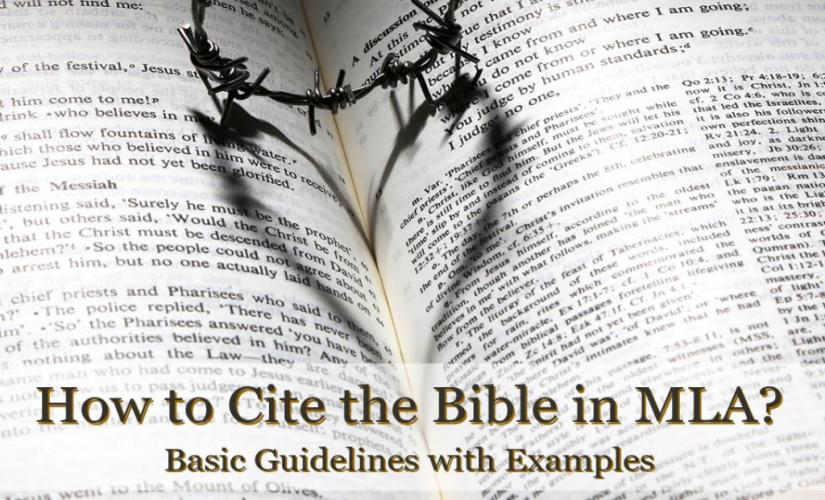Creating accurate citations plays an important role when writing research papers or essays in the MLA format because it allows one to enhance the quality of the information used to support main arguments. Basically, readers rely on cited evidence to understand the context of the quoted information. In this case, failing to cite all direct quotes or paraphrases leads to plagiarism. Then, one must consider citing the Bible since this type of source contains credible information for supporting significant arguments. In turn, there are different categories of Bibles that a writer may use to support significant arguments by using the MLA referencing style. However, one must give the edition and URL where necessary. Besides, one must ensure that each type of the Bible’s bibliographic entry follows the right procedure. Hence, learning how to cite the Bible in MLA is important in academic writing.
General Aspects of Citing the Bible in MLA
Citing sources is an important activity when writing research papers or essays because it shows that one completes the necessary work to make a credible argument. In this case, readers rely on cited information to understand the context of the quoted information. Also, citations give credit to sources. Then, failing to cite all direct quotes or paraphrases leads to plagiarism. In turn, the Bible contains credible information for supporting major arguments when writing a scholarly paper. Furthermore, there are different categories that scholars may use to support significant arguments. Finally, the most common types include printed, online, e-book, and other Bible formats. Besides, experienced and ethical writers must follow the right referencing guidelines when citing the Bible in MLA to support their central arguments.

Citing the Bible on the Works Cited Page
One requires the following details when creating the “Works Cited” page:
- Title of the Bible.
- Name of the editors – Scholars should provide this information if it is applicable.
- The version of the Bible – In most cases, the version of the Bible may differ from the title.
- Publication details – These may include publisher and place and date of publication.
1. Print Versions of the Bible
The bibliographic entry of a printed version of the Bible should include the title, version, editor, publishers, and year of publication. Basically, one must include the first and last name of the editor. Also, the title of the Bible should appear in italics. However, one should not italicize the version of the Bible. Then, a comma separates the main bibliographic details, like the title, version, city and publisher, and year when citing the Bible in MLA. In turn, a period should precede the version of the Bible. Hence, the following example shows the actual entry for a printed Bible:
- Skeleton of the citation – Bible Title, Bible Version, Edited by Editor, Publisher, Year of Publication.
- Actual citation – Holy Bible, King James Bible, Edited by John Doe. Nashville, Tn, Holman Bible Publishers, 1973.
2. Online Bible
Scholars use different guidelines to cite online versions of the Bible. For instance, one must include the title of the Bible, the website, a full URL, and the date accessed. In this case, the URL enables readers to access the Bible and ascertain its credibility. Besides, one must follow the correct punctuation marks during the citation process. Then, one should use a period to separate the title of the Bible and the website. However, commas separate the website, year of publication, and URL. Moreover, the URL should begin with “www” instead of “https://.” In turn, the date accessed should be the last item in the bibliographic entry. As a result, the following is an example of the bibliographic entry of an online Bible.
- Skeleton of the citation – Title of the Bible. Title of Website or Organization, full URL. Date Accessed.
- Actual citation – New International Version (NIV). Biblica.Com, 2011, www.biblica.com/bible/niv/genesis/2/. Accessed 6 July 2020.
3. E-Book Bible
MLA citation style requires one to cite an e-book Bible by including the title, edition, format, publisher, and year of publication. In this case, one must indicate that the Bible cited is an e-book. Hence, the following is an example of a citation of the e-book Bible.
- Skeleton of the citation – Title of the Bible. Edition, Format, Publisher, Year of Publication.
- Actual citation – The King James Version of the Bible. eBook, Project Gutenberg, 2011.
4. Different Translations
Some Bible versions appear in different translations. Today, different Bible translation exists in terms of mobile applications. Basically, one must identify the mobile app and the specific translation. Then, other important details that one must consider when developing the bibliographic entry include considering the right punctuation. In this case, the period must precede the title of the Bible and the name of the translation. Also, commas separate other details like the mobile app containing the translation. In turn, the title of the Bible and mobile app should be in italics. However, one may omit details about the mobile app if the translation appears in a different form. Therefore, the following example shows how a scholar must cite the Bible in MLA that appears in different translations:
- Skeleton of the citation – Title of the Bible. Name of translation. App Title, Date of Publication.
- Actual citation – The Holy Bible. Revised Standard Bible Version. YouVersion, British & Foreign Bible Society, 1996.
5. Different Editions
Bible versions appear in different versions. Basically, one should state the actual version used when writing a scholarly paper. For instance, the Bible’s bibliographic entry should contain the title, version, edition, city of publication, and publisher. In this entry, only the title of the Bible should appear in italics. Also, a scholar should use numerals when stating the edition of the Bible. However, the phrase “ed,” followed by a period, should precede the edition. As a result, the example of the Bible’s citations that exist in different versions is:
- Skeleton of the citation – Title of the Bible, Version. Edition. Place of Publication. Publisher, Year of Publication.
- Actual citation – Holy Bible, King James Bible. 2nd ed., Nashville, Tn, Holman Bible Publishers, 1973.
MLA In-Text Citation and Footnote
The in-text citation and footnote structures should follow the same format for all types of Bibles. For example, one must identify the quoted or paraphrased Bible verse. In this case, one must include the name of the book, and chapter and verse numbers when citing the Bible in MLA. Moreover, one should abbreviate longer book names. For instance, the abbreviation for the book of Genesis should be Gen. Also, the period must precede the abbreviated name. Then, the first in-text citation must include the italicized title of the Bible, which must match the one used in the “Works Cited” section. In turn, the subsequent citations or footnotes should include the name of the book and chapter and verse numbers. The following are the examples of the first and subsequent in-text citations.
- Skeleton of the first in-text citation format – Title of the Bible, Book Name Chapter. Verse)
- Actual citation/footnote of the first in-text citation format – (New International Version, Deut. 2.1)
- Skeleton of the subsequent citations/footnotes – (Book Name Chapter. Verse).
- The actual citation of the in-text citation/footnote – (Mark 2.1)
Summing Up on How to Cite the Bible in the MLA format
The Bible contains credible details that scholars can use to support their arguments when writing academic papers, essays, or other works. In this case, the MLA referencing style requires one to follow specific guidelines when creating the bibliographic entries, in-text citations, and footnotes. Moreover, the following are essential points that one must consider:
- The bibliographic entry of a printed version of the Bible should include the title, version, editor, publishers, and year of publication.
- One must include the title of the Bible, the website, a full URL, and date accessed when citing the online Bible version in MLA.
- One should include the title, edition, format, publisher, and year of publication when citing the e-book Bible in MLA.
- The bibliographic entry should contain the title, version, edition, city of publication, and the publisher when citing the Bible with different versions.


